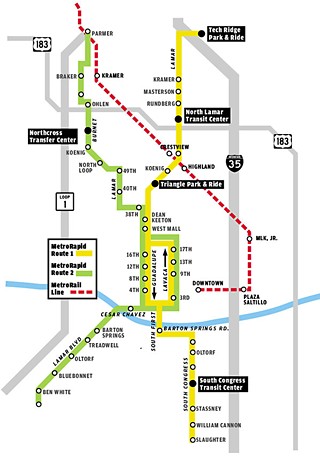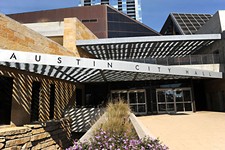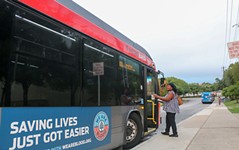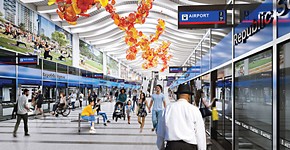FTA 'New Start' Funds MetroRapid Buses
Federal grant covers 80% of $47.6 million bus rapid transit program
By Richard Whittaker, Fri., April 20, 2012
"Austin has the distinction of having the greatest travel delays of any midsize city in the United States." That was the bleak diagnosis from Federal Transit Administrator Peter Rogoff when he visited Austin last week.
Rogoff was not in town for barbecue or to get stuck in traffic. He was signing a deal to bring $38 million in FTA New Starts funds for Cap Metro's MetroRapid bus rapid transit system. Within the context of Austin's slow-moving transit policy, the plan is pretty ambitious: to provide a viable new commuter link for the large suburban communities that work in the urban core, coming online in 2014. CapMetro plans to buy 22 60-foot articulated buses and 18 regular 40-foot buses. They will run along two north-south routes: The first will follow roughly the route of the 1L from the Tech Ridge Park & Ride through Downtown to Slaughter Lane, and the second will build on the 3 from Parmer Lane through town to the Westgate Transit Center. They will serve a total of 77 stops for 14 hours a day, running every 15 minutes and ramping up to every 10 minutes during rush hour. The plans also call for a dedicated Downtown bus lane, meaning the buses shouldn't slow to a crawl as soon as they hit UT and the Capitol complex. The stops should also provide a long-awaited service for passengers – real-time arrival information. "They're doing it right," said Rogoff.
For Rogoff's visit, Cap Metro borrowed an articulated bus from Canadian-based manufacturer Nova Bus, which has been selected to provide the vehicles. More commonly known as a "bendy" or caterpillar bus, they use the same kind of pivoting joint that links two carriages of a train. That means they can carry 102 passengers, compared with 72 for the 40-footers, and Cap Metro is looking at ways to increase the number of bikes and wheelchairs they can carry – a constant gripe for regular users. The transit authority argues that simply having these extra buses automatically doubles capacity. While the MetroRapid buses won't be as fast as, say, light rail serving the same route, they will automatically talk to traffic lights, shifting the timing so that they will stay green for long enough for the bus to get through. For Cap Metro, the real time saving will be in being able to get 20,000 commuters a day out of their cars and on to the buses.
Rogoff said, "For those folks whose work pattern and commuting hours mean they're going to be driving to work daily, having those transit riders off the highway to provide a less congested ride is of huge benefit to them." The project is not cheap, coming in at a total of $47.6 million. However, having the feds cover 80% of that cost takes the edge off that pain, as does the additional $3 million grant to replace parts of the aging regular fleet. "A lot of attention gets put on the new systems that we build out," said Rogoff, but "my biggest concern is the older systems that are underfinanced."
Unlike the Red Line commuter rail, which was locally funded and developed, the MetroRapid plan has been developed in concert with the FTA, and Rogoff explained that now that it is fully formed, he is happy to release the cash. He said, "It really is very consistent with what President Obama says about [an] 'all-of-the-above' strategy for dealing with gas prices." As far as the administration is concerned, he said, "extended rapid transit options really need to be a part of that strategy. It's really about giving folks the opportunity to keep more of their paycheck in their wallet, rather than hand it over at the gas pump."
But what about the naysayers who argue that middle-class commuters will never take the bus? "We certainly recognize that it's not going to make sense for everybody, and there're some people that are never going to take transit," he said. However, Rogoff argues that the transit agency must ensure rapid bus transit isn't just "express-bus lite, but instead to give it all of the amenities so it really shows the public all the benefits that you can get out of a bus." As for the naysayers, he added, "I think they grind their teeth until they find themselves riding the system."
Yet the politics of public transit, especially when the feds get involved, have become contentious. House Republicans recently made an unsuccessful attempt to sever transit from the Highway Trust Fund, and the FTA is still reeling from New Jersey Governor Chris Christie's decision to cancel a planned Hudson River rail tunnel. The governors of Florida, Wisconsin, and Ohio grabbed the front pages when they shunned billions of dollars in matching funds from the Federal Railroad Administration – but Rogoff argued that people need to look beyond those headline-grabbers. "There's far too much attention paid to them and not enough to the dozens of governors who are partnering with us," said Rogoff. He pointed to the negotiations between himself, U.S. Secretary of Transportation Ray LaHood and Republican Governor Rick Snyder of Michigan about using transit investment to aid the economic rehabilitation of Detroit and its suburbs. Similarly, fellow Republican Gov. Nathan Deal of Georgia, has been working with Atlanta's Democratic Mayor Kasim Reed and the regional chamber of commerce on a regional tax increase for transport and transit improvements. More importantly, Rogoff added, "The American people have recognized for some time that transit has to be part of the solution, even if it's not a solution for them personally."
Rogoff argues that no nut is impossible to crack. He said, "Who would have guessed, 20 years ago, that Dallas, Texas, would have more miles of light rail than any other city in the United States?" He suggested that the key is getting people exposed to transit for the first time. Take Phoenix: A ticket to the US Airways Center, home to the Phoenix Suns, is also a transit pass. "Having that option of going down to the event, not having to put up with the traffic that inevitably happens, and not having to pay to park, they're bringing people onto the system for the first time. And once they get on it, and realize that it's clean, efficient, and it's working for them, they start experimenting with it." Sometimes those experiments fail. For example, ridership goes up when gas prices rise, but goes down when the prices drop. However, Rogoff sees a silver lining – many of those passengers stick around. "That's partly economic, but partly because we convinced a new universe of riders that it makes sense for them."
The recurrent mantra is that the bus or train or tram does not replace the car – they are just one alternative to it. That is where Rogoff hopes the pocketbook appeal of switching to transit will prove most effective. The majority of what he dubbed "choice transit riders" are unlikely to get rid of a vehicle, but will save cash by just leaving it on the driveway or at the park & ride more. However, cars may start to look less appealing every year. Put aside rising gas prices or the looming threat of peak oil: Even if every gas-burning vehicle on the road was retrofitted tomorrow to run on renewable energy, there are only so many miles of road to put them on. Rogoff said: "The Census is telling us that the U.S. population is going to grow by 100 million people in just 40 years. Clearly, our current transportation strategies are not going to allow for economic growth if we have the added congestion that 100 million people bring." The seemingly never-ending growth of Austin and the I-35 corridor is a particularly pressing issue, especially since major companies are increasingly factoring transit provision into their location decisions. As local firms continue to recruit employees from cities where good transit is standard, "they're suddenly realizing that these things matter," he said.
It is that same middle-class commuter growth – or rather the increased population density – that will make transit viable in more cities. However, Rogoff warned against chasing choice transit riders at the expense of the transit-dependent. He said, "The systems that serve the broadest diversity of the community tend to be the ones that are the most successful because they have the greatest political support." If done correctly, transit planning can be used to leverage mixed-income development, which can have an impact on education, crime rates, and a whole slew of issues. "We've been working in concert with the Department of Housing and Urban Development and the [Environmental Protection Agency], and we've had successes around the country," he said.
Rogoff argued that the FTA's role in preparing for that denser future is in partnering with communities that are prepared to build integrated and diverse systems, "rather than just defaulting to what is often seen as one of the most expensive options – a rail system. That's one of the reasons that we like [bus rapid transit]." However, it's not just about handing out grants: His agency runs forums for municipalities going through similar growing pains, so they can share on best practices on technical issues like rerouting utilities to make way for streetcars. Rogoff said, "You gather them all round the table, and they learn that they don't have to suffer in silence."
Got something to say on the subject? Send a letter to the editor.













